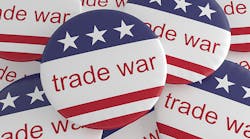The U.S.-China trade dispute is only just starting to bite. U.S-based manufacturers and tech firms, including HP, Dell, Microsoft and Apple are reportedly planning to shift hefty chunks of their production out of China. Meanwhile, the United States is intensifying its trade fight with the European Union over aircraft subsidies, proposing new tariffs on EU goods worth $4 billion.
Recent discussions I’ve had with political representatives and trade officials from several countries have reinforced the suspicion that this could, in fact, be the new normal.
It’s tempting for businesses with international supply chains to hope that we are in some kind of freak storm that will soon blow over. On the contrary, I believe businesses need to buckle up for a long and bumpy ride as the world retreats from free trade.
There’s no getting away from the fact that protectionism can cause major supply-chain headaches for companies in every sector. But it should also be viewed as an opportunity to diversify global operations, increase flexibility and reduce risks in ways that can make a business more resilient over the long term.
Here are five ways in which companies can prepare for this new world:
Invest in a new skill set. Many small to mid-sized companies need to raise their supply-chain game to ensure they are maximizing trade opportunities and minimizing risk. Often they only have a purchasing agent who looks at product costs but who lacks the more sophisticated skills needed to analyze crucial variables such as currency conversion, inventory holding costs, political risks, and supply chain distance. Strategically investing in agents with those critical skills and, along with it, an Enterprise Resource Planning (ERP) system that gives insights and visibility into supply chains, can give you an edge on the competition.
Treasure your treasury. As a company’s supply chain diversifies, it needs to get better at dealing with multiple currencies and put in place sophisticated foreign exchange strategies. Too many companies fall into the trap of thinking that by buying only in dollars, they are getting the best price and eliminating currency risk. Call it the dollar fallacy: It’s a strategy that only works if the whole supply chain is dollar-denominated, which is never the case in today’s globalized world.
Sticking to dollars raises the risk of paying inflated prices as your counterpart assumes the currency risk and passes on the price to you. Only by buying in local currency do you open up the possibilities presented by sophisticated hedging and transaction strategies. Most companies lack the resources to do this in-house, so should be talking to their bankers and other experts.
For example, just this weekend as President Trump announced another round of tariffs. The world watched as the Chinese reminbi (RMB) slid to near 11-year lows, providing a discount of about 1.5% for those buying in RMB but not for those buying in dollars.
Avoid knee-jerk reactions. While it’s important to diversify operations in response to changes in trade and economic policies, don’t be overly hasty about it. Any major changes to the supply chain need to be made with proper strategic planning and due diligence. If a supply chain shift—usually a costly, time-consuming, and complex process—seems too easy to be true, it probably is. To avoid penalties and other problems, be sure you verify the claims of Chinese joint venture partners who tell you they can easily shift China operations to a third country such as Vietnam. Proper due diligence includes making sure your people are on the factory floor in that third country, conducting surveillance audits, checking ownership documents and tracing the product’s journey.
Don’t break up with China. For the past 20 years, China has been the undisputed factory floor of the world. Now, in light of rising Chinese costs, the Washington-Beijing trade war, and the rise of alternative manufacturing hubs, it’s feasible for companies to cut China out of their supply chain altogether. I would argue that is a mistake. While caution on China is merited, the big picture is that it’s on course to be the world’s largest economy with world-beating companies in every sector. The best way to compete with that is by having a presence in the country to really understand what is happening there. So while China no longer has to be your one-stop solution or even your Asian hub, few companies should avoid it altogether.
Think regions, not countries. When you choose a particular country to operate from, you narrow your options and increase your risk profile. When you choose a region, by contrast, you open up your options and reduce your vulnerability to trade shocks. By taking a regional approach to supply chain decisions, you can take advantage of free-trade agreements and maneuver to maximize incentives while minimizing labor and other costs. Companies considering diversifying out of China, for example, often look to source from within the 10-nation ASEAN grouping that includes Malaysia, Singapore, Vietnam, and Thailand. A regional analysis of factors such as labor costs, tax costs, and political risks can help them make the right decision on which country or combination of countries is the best fit.
These adaptive strategies may not seem particularly urgent, especially if your business has yet to feel direct effects from the stiffening trade winds. But if the past two years have taught us anything, it’s that change can happen very quickly and have a profound impact.
Lou Longo is the International Consulting Practice Leader at Plante Moran.
[PL1]Supplier?




